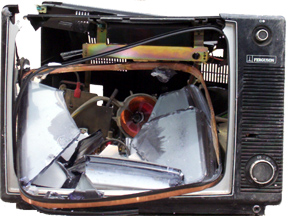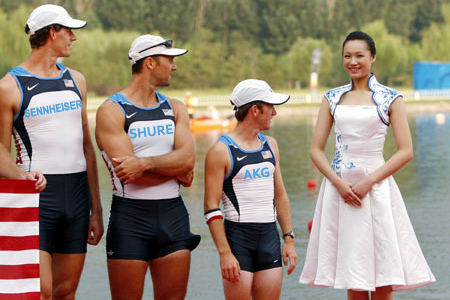It wasn't that long ago that Wireless Waffle was discussing the need for spectrum for programme making and special events (PMSE). At the time we were considering how the needs of the burgeoning demand for radio spectrum for the Eurovision Song Contest would be met. Most radiomicrophones currently operate in the UHF television band, in the gaps between transmitters. These gaps (which are there to protect neighbouring television transmitters from interfering with each other) are also being eyed by the wireless broadband and machine-to-machine community amongst others and have been given the moniker 'white space' (though one person infinitely more learned in these things believes they should correctly be considered 'grey spaces' as they aren't as white as you might believe).
 There are also moves afoot to squash television broadcasting into even less spectrum to make way for more mobile broadband. At present the spectrum from 470 to 790 MHz is generally available (40 channels - channels 21 to 60). The new plans involve using the spectrum from 694 MHz upwards for more mobile broadband leaving the terrestrial television broadcasters with just 28 channels (channels 21 to 48). And at the moment, there is no guarantee that there won't be further erosion of the UHF television band for other uses.
There are also moves afoot to squash television broadcasting into even less spectrum to make way for more mobile broadband. At present the spectrum from 470 to 790 MHz is generally available (40 channels - channels 21 to 60). The new plans involve using the spectrum from 694 MHz upwards for more mobile broadband leaving the terrestrial television broadcasters with just 28 channels (channels 21 to 48). And at the moment, there is no guarantee that there won't be further erosion of the UHF television band for other uses.
If TV use is squashed into less spectrum, there will be less 'grey space' available for radiomicrophones, or for anyone else for that matter. To make matters worse, the tuning range of most radiomicrophones (and similar devices) is very limited and each time they are forced to change frequency, new equipment needs to be bought. Of course, this is good news for manufacturers such as Sennheiser and Shure, but is bad news for the end users.
The need for spectrum for radiomicrophones and other PMSE uses is recognised at an European level in the Radio Spectrum Policy Programme (RSPP) article 8.5 of which states:
So what can be done? Are PMSE users to be left as the nomads of the radio spectrum, packing down their camps, wandering across the desert and re-assembling their tents in a new area every 3-4 years? Or is there a long(er)-term solution that would allow them to lay solid foundations and put down some bricks?
For many years, a band at 1785 - 1800 MHz has been available for wireless microphone use, but only for digital microphones (see CEPT Report 50). Almost no use has been made of the band and the views of Audio-Technica illustrate why this is the case:
 Using diversity reception (already commonplace in radiomicrophone equipment) and careful antenna placement, there is no reason why the 1.8 GHz band could not prove useful. But one of the other problems with this band is that radiomicrophones are not well suited to using digital technology. To send audio digitally, it must first be converted from analogue to digital. For 'high quality' audio, this would yield a 'raw' data rate of at least 512 kbps, if not more - and more like 1 Mbps by the time error correction is added in. If we were to try to transmit this data in the 200 kHz channels that microphones currently use, we would have to use a high-order modulation scheme (such as 8-PSK or 16 QAM) and this causes problems because:
Using diversity reception (already commonplace in radiomicrophone equipment) and careful antenna placement, there is no reason why the 1.8 GHz band could not prove useful. But one of the other problems with this band is that radiomicrophones are not well suited to using digital technology. To send audio digitally, it must first be converted from analogue to digital. For 'high quality' audio, this would yield a 'raw' data rate of at least 512 kbps, if not more - and more like 1 Mbps by the time error correction is added in. If we were to try to transmit this data in the 200 kHz channels that microphones currently use, we would have to use a high-order modulation scheme (such as 8-PSK or 16 QAM) and this causes problems because:
This means that the other way in which digital systems use spectrum efficiently is also a no-go. Compressing the data (e.g. using a compressed audio format such as mp3 instead of the raw digitised audio) also takes time - generally longer than the time taken to transmit the signal digitally. And so we reach an impasse: compressing the audio to use less spectrum takes too long, and transmitting the raw data uses more spectrum than their analogue counterpart and involves a number of other trade-offs. All this means that digital radiomicrophones, whilst slowly being developed, tend to offer no better performance than analogue versions (and at much higher cost).
But the fact is, that if the radiomicrophone industry does not make some strides towards adopting higher frequencies or more spectrum efficient modulation techniques, it might find itself without enough spectrum in which to operate.
So where could microphones go? There are a whole host of frequencies which are currently assigned at a European level by CEPT for radiomicrophone use (as per ERC Recommendation 70-03, Annex 10). These include:

 There are also moves afoot to squash television broadcasting into even less spectrum to make way for more mobile broadband. At present the spectrum from 470 to 790 MHz is generally available (40 channels - channels 21 to 60). The new plans involve using the spectrum from 694 MHz upwards for more mobile broadband leaving the terrestrial television broadcasters with just 28 channels (channels 21 to 48). And at the moment, there is no guarantee that there won't be further erosion of the UHF television band for other uses.
There are also moves afoot to squash television broadcasting into even less spectrum to make way for more mobile broadband. At present the spectrum from 470 to 790 MHz is generally available (40 channels - channels 21 to 60). The new plans involve using the spectrum from 694 MHz upwards for more mobile broadband leaving the terrestrial television broadcasters with just 28 channels (channels 21 to 48). And at the moment, there is no guarantee that there won't be further erosion of the UHF television band for other uses.If TV use is squashed into less spectrum, there will be less 'grey space' available for radiomicrophones, or for anyone else for that matter. To make matters worse, the tuning range of most radiomicrophones (and similar devices) is very limited and each time they are forced to change frequency, new equipment needs to be bought. Of course, this is good news for manufacturers such as Sennheiser and Shure, but is bad news for the end users.
The need for spectrum for radiomicrophones and other PMSE uses is recognised at an European level in the Radio Spectrum Policy Programme (RSPP) article 8.5 of which states:
Member States shall, in cooperation with the Commission, seek to ensure the necessary frequency bands for PMSE, in accordance with the Union's objectives to improve the integration of internal market and access to culture.
So what can be done? Are PMSE users to be left as the nomads of the radio spectrum, packing down their camps, wandering across the desert and re-assembling their tents in a new area every 3-4 years? Or is there a long(er)-term solution that would allow them to lay solid foundations and put down some bricks?
For many years, a band at 1785 - 1800 MHz has been available for wireless microphone use, but only for digital microphones (see CEPT Report 50). Almost no use has been made of the band and the views of Audio-Technica illustrate why this is the case:
The frequency range [1800 MHz] is not really suited for wireless microphones, as the higher frequencies (i.e. shorter wavelengths) create more body absorption and shadow effects due to the directivity, etc. The use of these frequencies will only work adequately when there is a line of sight and a short distance between the transmitter and the receiver.
 Using diversity reception (already commonplace in radiomicrophone equipment) and careful antenna placement, there is no reason why the 1.8 GHz band could not prove useful. But one of the other problems with this band is that radiomicrophones are not well suited to using digital technology. To send audio digitally, it must first be converted from analogue to digital. For 'high quality' audio, this would yield a 'raw' data rate of at least 512 kbps, if not more - and more like 1 Mbps by the time error correction is added in. If we were to try to transmit this data in the 200 kHz channels that microphones currently use, we would have to use a high-order modulation scheme (such as 8-PSK or 16 QAM) and this causes problems because:
Using diversity reception (already commonplace in radiomicrophone equipment) and careful antenna placement, there is no reason why the 1.8 GHz band could not prove useful. But one of the other problems with this band is that radiomicrophones are not well suited to using digital technology. To send audio digitally, it must first be converted from analogue to digital. For 'high quality' audio, this would yield a 'raw' data rate of at least 512 kbps, if not more - and more like 1 Mbps by the time error correction is added in. If we were to try to transmit this data in the 200 kHz channels that microphones currently use, we would have to use a high-order modulation scheme (such as 8-PSK or 16 QAM) and this causes problems because:- transmitters need to be linear meaning they draw more power and would drain batteries much more quickly;
- higher-order modulation schemes require decent signal-to-noise levels and thus higher powered transmitters;
- it takes time to encode and decode complex modulation schemes.
This means that the other way in which digital systems use spectrum efficiently is also a no-go. Compressing the data (e.g. using a compressed audio format such as mp3 instead of the raw digitised audio) also takes time - generally longer than the time taken to transmit the signal digitally. And so we reach an impasse: compressing the audio to use less spectrum takes too long, and transmitting the raw data uses more spectrum than their analogue counterpart and involves a number of other trade-offs. All this means that digital radiomicrophones, whilst slowly being developed, tend to offer no better performance than analogue versions (and at much higher cost).
But the fact is, that if the radiomicrophone industry does not make some strides towards adopting higher frequencies or more spectrum efficient modulation techniques, it might find itself without enough spectrum in which to operate.
So where could microphones go? There are a whole host of frequencies which are currently assigned at a European level by CEPT for radiomicrophone use (as per ERC Recommendation 70-03, Annex 10). These include:
- 29.7 - 47 MHz - manufacturers claim that these frequencies are not ideal as they are too noisy and antennas are too large (fussy lot aren't they)
- 174 - 216 MHz - VHF band III - mostly occupied by TV broadcasting and DAB radio
- 470 - 790 MHz - the aforementioned UHF band that is now being squeezed
- 863 - 865 MHz - licence exempt and shared with other devices
- 1785 - 1805 MHz - 'too high'
- 1215 - 1350 MHz - mostly an aeronautical radar band but shared with many other uses and therefore presumably sharable with others
- 1350 - 1400 MHz - low capacity fixed links and some mobile services
- 1492 - 1518 MHz - more low capacity fixed links - and already proposed in ERC 70-03 but available in a tiny amount in the UK only
- 1675 - 1710 MHz - a downlink band for meteorological satellites but not heavily used - sterilisation zones around official downlink sites would protect professional users

2 comments
( 4697 views )
| permalink
| 



 ( 2.7 / 2016 )
( 2.7 / 2016 )




 ( 2.7 / 2016 )
( 2.7 / 2016 )

